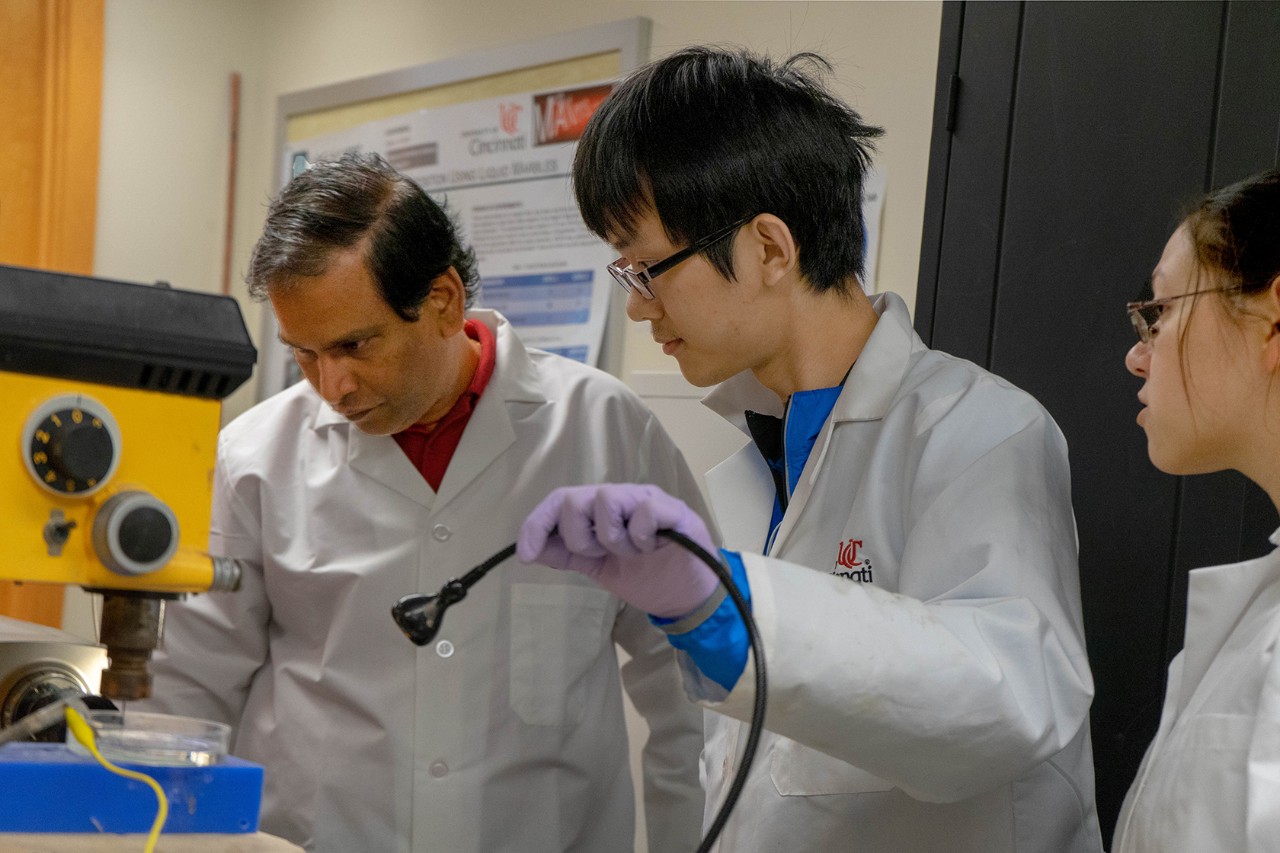
UC professor researches novel glass machining
Murali Sundaram receives an NSF grant for his study of gas film in the glass machining process

One of Murali Sundarim's graduate students works in the lab. Photo/Corrie Stookey/CEAS Marketing
Glass is becoming increasingly important in biomedical, electronic, automotive and energy fields. Potential emerging applications for glass include packaging, brake linings, prosthetics and fuel cells. But manufacturing this glass is another story.
University of Cincinnati Associate Professor of Mechanical Engineering Murali Sundaram, Ph.D., recently received a National Science Foundation (NSF) grant for $301,472 for his work, “A Fundamental Study on Gas Film Formation and Its Effect in Electrochemical Discharge Machining Process.” He is researching how to manipulate manufactured ceramics like glass.
“Everybody knows glass is a very difficult material to machine, but it has many good properties,” says Sundaram. “I am studying how we can machine manufactured glass into a ready-to-use state.”
Currently, if you want to manufacture something made of glass, or a glass-like property like porcelain, you have to mold each individual product into its final shape in the manufacturing process. You cannot shape a chunk of glass into something you want, as you can with metals or plastics, because of the physical composition of the glass itself. Should you drill into a glass item, that item will crack and become useless.
“Any glass you have – for example, a teacup – is made into its final shape, so you can readily use it,” says Sundaram. “Now we are going beyond that.”
Rather than applying metal machining techniques to glass, Sundaram is studying the application electrochemical discharge machining to the shaping of glass.
Everybody knows glass is a very difficult material to machine, but it has many good properties.
Murali Sundaram, UC professor of mechanical engineering
Electrochemical discharge machining is a nontraditional manufacturing process that improves the surface integrity of materials like glass. A tool discharges sparks (caused by electric currents) through a nonconductive material – in this case, glass – and heats up the material. Because of the electrochemical and thermal reactions, gas forms as a byproduct.
This gas film, and the heat that comes from the electric current, is what actually drives the machining process. It’s also what Sundaram is most interested in.
“People pay attention to electrical parameters, but they always ignore the gas film that is doing the job,” says Sundaram. “We want to understand how this gas film is formed and how we can control that.”

An image of a hole in a sheet of glass created by glass machining. Photo/Provided
Gas bubbles naturally stick to a solid surface – in this case, the tool facilitating electric discharges and the glass material. It makes more sense if we imagine lightning, says Sundaram. Lightning currents jump from cloud to cloud. Like lightning, the electric current from the tool can jump from one gas bubble to another, creating energy that becomes the heat driving the glass machining.
By studying the gas film that forms during this process, Sundaram can better understand the machining process of glass and start controlling it. If not, the gas that forms during glass machining may remain an unpredictable process, and, therefore, unpopular with industries.
Sundaram hopes machining glass will someday become as simple drilling into a material. “You don’t have to be an engineer to drill a hole with a drill press, but you know exactly what’s going to happen,” he says. “That type of understanding is what we are going for with glass.”
Sundaram has a PhD student and master’s student working with him on this project, but he welcomes any undergraduate students interested in innovative manufacturing technology to contact him.
“Our lab is open to all undergraduate students who want to become researchers,” says Sundaram.
With the grant from the National Science Foundation, Sundaram and UC students can start shaping the machining process for ceramic materials like glass. Someday, your morning routine – from drinking coffee out of a mug to brushing your teeth in the sink – may be shaped by this same research.
Featured image at top: UC professor Murali Sundarim works with two of his graduate students in the lab. Photo/Corrie Stookey/CEAS Marketing.
Find your path
Interested in encouraging others as you find your path to academic success? If so, apply to UC as an undergrad or graduate inspirational Bearcat. As part of UC's Next Lives Here strategic direction, UC's students makes positive and real-world impact.
Related Stories
UC’s Ground Floor Makerspace births combat robots
April 17, 2024
In the heart of UC's 1819 Innovation Hub lies the Ground Floor Makerspace, an advanced and active hub of ingenuity where students, faculty and the community converge to bring their ideas to life. This includes being the birthplace of robots much like miniature race cars, combating fender to fender in an enclosed boxing ring. Combat robots like UC's Maximizer will again be fighting for first place in the National Havoc Robot League (NHRL) competition, slated for April 20.
UC researchers develop new CPAP device
April 17, 2024
Researchers at the University of Cincinnati are developing a VortexPAP machine that takes advantage of vortex airflow technology. A preliminary clinical study with current CPAP users demonstrated that the VortexPAP can deliver the pressure levels that are used in the subjects’ CPAP therapy, but the mask is more comfortable to wear. It has a minimalistic design that is less intrusive and barely touches the patient’s face.
UC architectural engineering alumna inspires high school students
April 16, 2024
University of Cincinnati alumna Emma Wilhelmus fell in love with engineering when she was in ninth grade. After taking drafting, architecture and engineering courses in high school, she set out to major in architectural engineering in college. Now, she is an engineering teacher at a local high school and hopes to inspire students.
